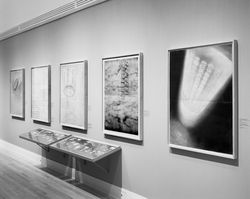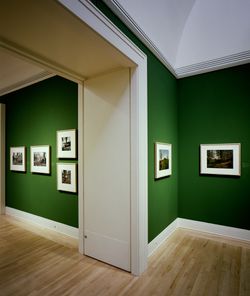John Soane 1753-1837
Described by Henry James as “one of the most curious things in London,” Sir John Soane’s Museum was built as the picturesque and enigmatic home, office, collector’s trove, and personal showplace of one of history’s most innovative architects. This exhibition is a major re-evaluation of Soane’s career, as well as a reconsideration of his importance to the history of modern(...)
Main galleries
16 May 2001 to 3 September 2001
John Soane 1753-1837
Actions:
Description:
Described by Henry James as “one of the most curious things in London,” Sir John Soane’s Museum was built as the picturesque and enigmatic home, office, collector’s trove, and personal showplace of one of history’s most innovative architects. This exhibition is a major re-evaluation of Soane’s career, as well as a reconsideration of his importance to the history of modern(...)
Main galleries
Technological advances as well as the general social, political, and economic climate have always been of great interest to architects. Toys and the Modernist Tradition examines at how toy manufacturers responded to the exciting and rapidly changing ideas of modern architects. Many of the exhibited toys were designed by leading architects of the modern movement, including(...)
Toys and the Modernist Tradition
Actions:
Description:
Technological advances as well as the general social, political, and economic climate have always been of great interest to architects. Toys and the Modernist Tradition examines at how toy manufacturers responded to the exciting and rapidly changing ideas of modern architects. Many of the exhibited toys were designed by leading architects of the modern movement, including(...)
exhibitions
Victorian medical experts insisted that houses were like bodies—that buildings could be sick—and that healthy architecture entailed a “systematic” approach to domestic sanitation, drawing from the burgeoning field of physiology. *Corpus Sanum in Domo Sano—“a healthy body in a healthy house”—explores the spatial, professional, and gender implications of the(...)
Hall cases
13 November 1991 to 16 February 1992
Corpus Sanum in Domo Sano: The Architecture of the Domestic Sanitation Movement, 1870-1914
Actions:
Description:
Victorian medical experts insisted that houses were like bodies—that buildings could be sick—and that healthy architecture entailed a “systematic” approach to domestic sanitation, drawing from the burgeoning field of physiology. *Corpus Sanum in Domo Sano—“a healthy body in a healthy house”—explores the spatial, professional, and gender implications of the(...)
exhibitions
13 November 1991 to
16 February 1992
Hall cases
Amid education reform in American schools of architecture in the 1970s, Kenneth Frampton was integral in transforming the curriculum of Columbia University’s Graduate School of Architecture Planning. In particular, he designed and taught what became three core courses: the theory seminar “Comparative Critical Analysis,” the history lectures “Thresholds of Modern(...)
31 May 2017 to 24 September 2017
Educating Architects: Four Courses by Kenneth Frampton
Actions:
Description:
Amid education reform in American schools of architecture in the 1970s, Kenneth Frampton was integral in transforming the curriculum of Columbia University’s Graduate School of Architecture Planning. In particular, he designed and taught what became three core courses: the theory seminar “Comparative Critical Analysis,” the history lectures “Thresholds of Modern(...)
The exhibition explores one of the most adventurous and influential moments in the history of architecture: the explosion of invention and ideas that followed the October Revolution in Russia. The Soviet avant-garde architects were productivist as much as aesthetic in their concerns; they saw architecture and the arts as one, and they were committed to bringing design(...)
Main galleries
19 June 1991 to 8 September 1991
Architectural Drawings of the Russian Avant-Garde, 1917-1935
Actions:
Description:
The exhibition explores one of the most adventurous and influential moments in the history of architecture: the explosion of invention and ideas that followed the October Revolution in Russia. The Soviet avant-garde architects were productivist as much as aesthetic in their concerns; they saw architecture and the arts as one, and they were committed to bringing design(...)
Main galleries
After a period of decline, the architectural model gained new prominence when it became a popular tool for design education and practice in the early twentieth century. This revival is usually associated with the turn towards objectivity and the search for expressive means to communicate ideas in three dimensions—but how was the model transformed in the age of its(...)
Octagonal gallery
22 September 2011 to 8 January 2012
Modernism in Miniature: Points of View
Actions:
Description:
After a period of decline, the architectural model gained new prominence when it became a popular tool for design education and practice in the early twentieth century. This revival is usually associated with the turn towards objectivity and the search for expressive means to communicate ideas in three dimensions—but how was the model transformed in the age of its(...)
Octagonal gallery
Édouard Baldus, more than any other photographer, defined the modern landscape and established the standard for architectural photography. The Photographs of Édouard Baldus: Landscapes and Monuments of France chronicles the Golden Age of France as seen by the photographer. The Photographs of Édouard Baldus is organized by chronological sections to reveal the evolution of(...)
Main galleries
25 January 1995 to 23 April 1995
The Photographs of Édouard Baldus: Landscapes and Monuments of France
Actions:
Description:
Édouard Baldus, more than any other photographer, defined the modern landscape and established the standard for architectural photography. The Photographs of Édouard Baldus: Landscapes and Monuments of France chronicles the Golden Age of France as seen by the photographer. The Photographs of Édouard Baldus is organized by chronological sections to reveal the evolution of(...)
Main galleries
Mies in America
A profound thinker, painstaking artist, and one of the greatest architects in history, Ludwig Mies van der Rohe emigrated from Germany to the United States in 1938, when he was already in his fifties and one of the recognized masters of his profession. Transplanted from the Bauhaus (of which he was the last director) to a technical institute in Chicago, from the European(...)
Main galleries
17 October 2001 to 20 January 2002
Mies in America
Actions:
Description:
A profound thinker, painstaking artist, and one of the greatest architects in history, Ludwig Mies van der Rohe emigrated from Germany to the United States in 1938, when he was already in his fifties and one of the recognized masters of his profession. Transplanted from the Bauhaus (of which he was the last director) to a technical institute in Chicago, from the European(...)
Main galleries
Through the work of internationally renowned architects, this exhibition reveals the presence of utopian modernist ideas thought to have been discarded with the advent of the postmodern era. According to the exhibition’s lead curator Reinhold Martin, much of the architectural production of the last half-century has been haunted by the ghosts of modernist utopias: “The(...)
Octagonal gallery
28 February 2008 to 25 May 2008
Utopia's Ghost: Postmodernism Reconsidered
Actions:
Description:
Through the work of internationally renowned architects, this exhibition reveals the presence of utopian modernist ideas thought to have been discarded with the advent of the postmodern era. According to the exhibition’s lead curator Reinhold Martin, much of the architectural production of the last half-century has been haunted by the ghosts of modernist utopias: “The(...)
Octagonal gallery
Through a commission from the CCA, three contemporary photographers spent six years interpreting the work of Frederick Law Olmsted (1822–1903), North America’s most important landscape architect. *Viewing Olmsted: Photographs by Robert Burley, Lee Friedlander, and Geoffrey James* presents 155 photographs from this commission to offer visitors an opportunity to understand(...)
Main galleries
16 October 1996 to 2 February 1997
Viewing Olmsted: Photographs by Robert Burley, Lee Friedlander, and Geoffrey James
Actions:
Description:
Through a commission from the CCA, three contemporary photographers spent six years interpreting the work of Frederick Law Olmsted (1822–1903), North America’s most important landscape architect. *Viewing Olmsted: Photographs by Robert Burley, Lee Friedlander, and Geoffrey James* presents 155 photographs from this commission to offer visitors an opportunity to understand(...)
Main galleries








